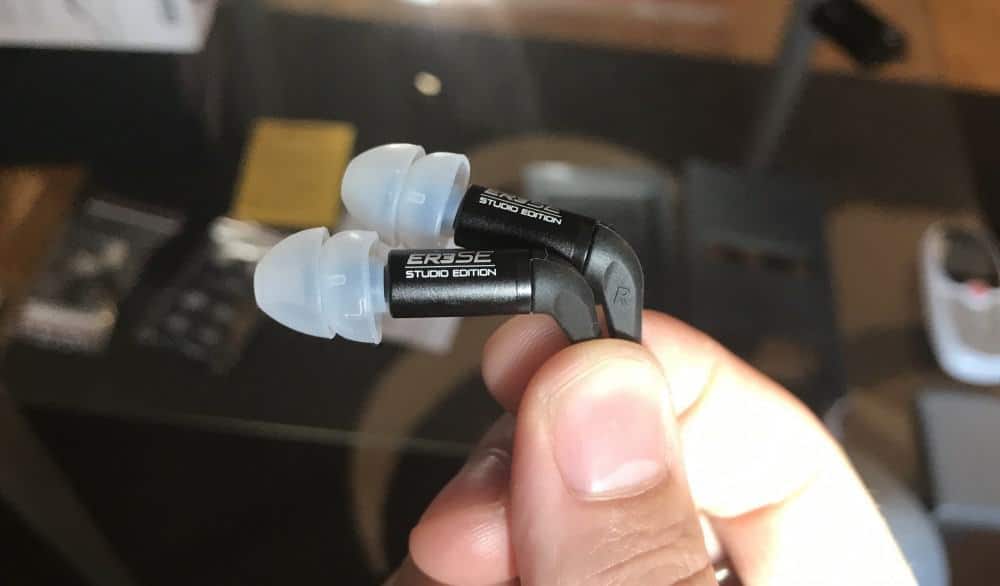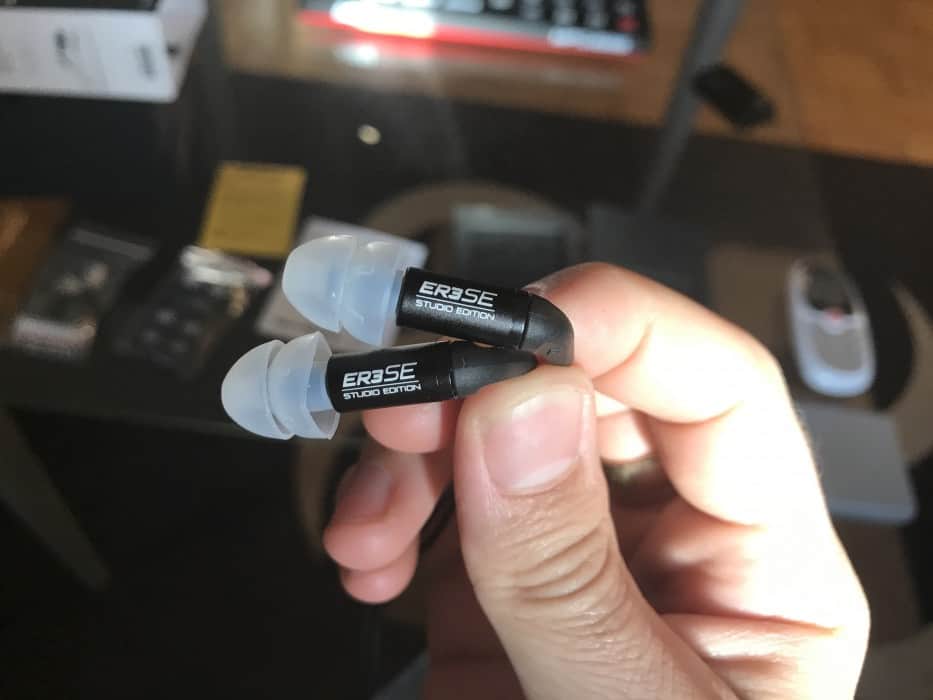As an Amazon Associate, I earn from qualifying purchases. Additionally, I earn a commission through each purchase made on Amazon, Clickbank, zZounds, Plugin Boutique, Plugin Fox, Thomann, Jam Play, and Punkademic from one of my links.
There’s something about a solid pair of earbuds that excites me. Maybe it’s because I’ve preferred using them almost my entire life.
Some people out there actually prefer using earbuds for creating music, and I would be lying if I said I didn’t use them around 70% of the time.
While they may not be the best for mixing and mastering, earbuds are easy to carry around with you due to their compact size and design.
The best earbud headphones for music production are Etymotic Research’s ER3SE Headphones, due to their overall value, price, and design, in addition to their aim for flat frequency response.

Etymotic’s ER3SE Headphones
If you’ve researched monitors on the internet for any amount of time, you’ve likely come across the Etymotic ER3SE’s (from Amazon).
There are a ton of earbuds out there that sound pretty good, but typically, you’ll run into problems with the design, the build quality, durability, boosted low-end, or even just getting them to fit in your ears properly.
When it comes to making music, I – and it’s probably safe to assume, many others – think it’s wise to grab headphones that offer somewhat of a neutral response, rather than bass-boosting headphones.
It’s not uncommon for earbud headphones and other consumer-level products to boast a boosted bass response, which isn’t really what we want for creating music. What we’re looking for is accuracy.
We’re mostly looking for quality headphones with a defined, detailed, and accurate sound, rather than a boosted low-end. This is where Etymotic Research’s ER3SE shine. With all that in mind, these earbuds should not be your primary studio monitors.
In the case that you’re looking for over-the-ear studio monitors, it’s best to opt for headphones like Audio Technica’s ATH-M50x or Beyerdynamic’s DT 990 PROs (also from Amazon) which are undoubtedly the best headphones I own.
The Best Quality Of The ER3SEs
We want to use headphones that aim for neutrality and accuracy, rather than a boosted low-end because we’re looking for a faithful representation of the music.
What I like about these headphones the most is the fact they’re small and portable, but they also aim for flat frequency response. Because I work outside of my home on a regular basis, I need flat, easy-to-carry headphones. When I’m on break from my job, I’ll usually come up with an idea for a song on my computer (by the way, this is the MacBook Pro I recommend from Amazon).
For this reason, I like having the ER3SEs because then I have studio-quality headphones without having to carry around massive over-the-ear monitors. Whenever I’m done with them, I store the ER3SEs in their carrying case.
There’s no doubt that these are my number one pair of headphones right now in terms of what I use the most because of their earbud-style and “flat”-frequency response.
The reason why I like them like this is because I can use them to study my own mixes and the mixes of others while I’m on the go, listening to music on the train, on the bus, out for walks, etc.
The ER3SEs serve this purpose well, because I’m able to accurately study other people’s music, as well as my own, that way I know what changes have to be made to a mix to either improve mine or how I would improve the mix of someone else (how to mix with my guide).
Then, I write what I need to change about my mix in a notepad on my phone, that way I don’t forget.
What Comes In The Box
- Earphones with a detachable, 4-foot cord with a 3.5 mm gold-plated stereo plug.
- An assortment of 10 ear-tips of varying sizes.
- A nice little traveling case.
- Filter removal tool.
- Shirt clip
- Instruction manual and warranty.

Specifications
Frequency Response: 20Hz to 16,000kHz
Transducers: High-Performance, balanced armature drivers
Impedance: 22ohms
Sensitivity: 103dB (@1kHz SPL at 0.1V)
Maximum Output: 120 dB SPL
Cable Style: Detachable 4-foot cable
What They Sound Like
Etymotic’s ER3SE’s primary selling point is the sound quality, which has garnered rave reviews among people who’ve used them.
Arguably the best aspect of the headphones is their balanced and detailed feel.
Before I owned these ones, I actually had my hands on the ER3XR, which are the bass-boosted version, because I bought them by mistake. Right away, when I started using the ER3SEs, I noticed the difference in the bass.
The best music out there is typically detailed with a lot of instruments, sounds, and effects, and a solid pair of headphones are able to communicate all of those sounds without any of it sounding muffled or muddy.
Etymotic’s ER3SE headphones are great in this way.
They’re able to showcase the detail in music without muddying each frequency range. Every part of the mix sounds nice and distinguished, which is great for creating music.
These are actually the second pair of “flat” earbuds that I’ve owned, and the difference between these and my Sony headphones with the boosted-bass response is readily apparent.
The ER3SEs really do sound quite flat.
When comparing the high, mid, and low-end response, there isn’t one particular area of the frequency spectrum that significantly outshines the other.
Style and Design
The style and design of the ER3SEs are a lot different in comparison to other headphones on the market. They look like little hammers, even the way that you put them together is quite different.
When I first opened the box, I had to look at the instruction manual to ensure that I wasn’t going to break them when I wanted to take off the rubber tip and replace them for a bigger pair.
What’s interesting about them is that the actual speaker is so incredibly small, but then when you attach the rubber tip, they look more normal in size.

From what I can tell, the headphones themselves appear to be made out of steel, which I’m a big fan of. If they are plastic, it’s very hard plastic.
They don’t give off a cheap and poorly-made vibe. Put simply, they’re well-constructed.
I believe they come in black only, and the product name is printed on the side of each headphone.

There’s no question that the design of these headphones is quite unique, and I have to give them credit for being different.
Comfort
In terms of comfort, there really isn’t much to say about them because they’re earbud headphones.
They go directly into your ear, and how they feel depends a lot more on the size of the rubber tip you choose.
With that in mind, I haven’t noticed them falling out of my ears at all when I walk around, which is great news for those of us who have that problem.
If you do run into that issue, it means that you just need to swap out the rubber tips and choose a slightly bigger one to ensure they stay in your ear.
Cons
1) Price
The ER3SEs are expensive, there’s no doubt about it. But it all depends on how serious you are about mixing and getting your music to sound good.
For me, it’s essential to have a great pair of headphones to study mixes and reference tracks (my guide on this), but that’s me.
While they are pricey, the good thing about them is what I’ve already mentioned above: that being that the cable is replaceable, which is typically what breaks first. You can find the replacement cable at this link here
In other words, they can last a long time if you’re willing to replace them if they break.
2) Frequency Only Goes Up To 16,000kHz
It’s a bit unfortunate that they only go up to 16,000kHz, but that’s ok. Truthfully, there aren’t that many frequencies past this point anyway, but I still think it would’ve been nice to have them go from 20Hz to 20,000kHz.
Important Things To Note
- Look at the instruction manual if you want to take them apart. It’s not wise to twist and turn them whenever you’re trying to detach the actual headphone from the cable. They’re pulled, rather than twisted off and they make a snapping sound when properly attached.
- The rubber tips are very snug. To remove the rubber tips, you can twist and turn them.
- To put the rubber tips on, you have to push hard to get them to fit snugly on the speaker.
- There’s a filter-removal tool in the case that the filter inside the headphone gets too dirty.
- The regular iPhone headphone adaptor works just fine. However, make sure that the headphone cable literally snaps in place when you plug it into the adaptor, otherwise, you’re going to get crackling noises on account of the lack of proper connection.
- The ER3SE’s have since been updated to the ER4SRs which you can also find on Amazon.
How To Detach The Etymotic ER3SE
If you want to detach the headphone from the rest of the cable, what you want to do is pull on the handle of the headphone cable that’s shown on the left-hand side here, while pulling down on the actual headphone. As I said above, you want to make sure that you don’t twist and turn. It doesn’t come off that way, it has to be pulled.

YouTube Video Review
Conclusion
As I mentioned already, I would argue that these aren’t supposed to be your primary monitoring headphones. I use them during the music production process; for studying my own mixes and that of others while I’m going about my daily tasks, and then I use them for a frame of reference during the mixing phase.
I’ll typically use these first or the iLoud Micro Monitors if I want the music to be loud, and then I’ll throw on the DT 990 PROs when I’m getting really serious about the mix and I’m getting ready to add the finishing touches.
All-in-all, Eytmotic’s ER3SEs are a great option if you’re looking for a solid pair of earbuds that aim for flat frequency response. These are great for almost every type of listening that you’ll need to do, including music production and casual listening. I’m definitely glad I bought them.

 Written By :
Written By :